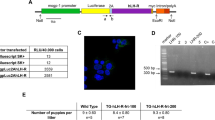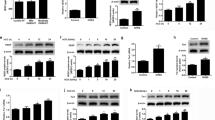Abstract
The lipid growth factor lysophosphatidic acid (LPA) is produced by ovarian cancer cells in quantities sufficient to attain concentrations of up to 10 μ M. An autocrine circuit was demonstrated when ovarian cancer cells, but not normal ovarian surface epithelial cells, were proven to express LPA2 (Edg-4) and LPA3 (Edg-7) G protein-coupled receptors for LPA. Human LPA2 now has been expressed transgenically in C57BL/6 mouse ovaries under direction of the α-inhibin large promoter. Human LPA2 mRNA and protein were detected in all transgenic (TG) mouse ovaries at levels far higher than in other tissues and at least fivefold higher than in cultured lines of human ovarian cancer cells, with the expected sex cord-stromal distribution. Most LPA2 TG ovaries produced significantly higher levels than non-TG ovaries of type A, but not type B, vascular endothelial growth factor (VEGF), isomers of VEGF-A, and urokinase-type plasminogen activator (uPA). Many LPA2 TG ovaries had elevated expression of VEGF receptors 1 and 2, and a depressed level of type 2 PA inhibitor. Thus, the LPA–LPA2 circuit regulates ovarian cells both directly and through increases in protein growth factor systems.
This is a preview of subscription content, access via your institution
Access options
Subscribe to this journal
Receive 50 print issues and online access
$259.00 per year
only $5.18 per issue
Buy this article
- Purchase on Springer Link
- Instant access to full article PDF
Prices may be subject to local taxes which are calculated during checkout









Similar content being viewed by others
References
Aoki J, Taira A, Takanezawa Y, Kishi Y, Hama K, Kishimoto T, Mizuno K, Saku K, Taguchi R and Arai H . (2002). J. Biol. Chem., 277, 48737–48744.
Baudhuin LM, Cristina KL, Lu J and Xu Y . (2002). Mol. Pharmacol., 62, 660–671.
Boocock CA, Charnock-Jones DS, Sharkey AM, McLaren J, Barker PJ, Wright KA, Twentyman PR and Smith SK . (1995). J. Natl. Cancer Inst., 87, 506–516.
Chun J, Goetzl EJ, Hla T, Igarashi Y, Lynch KR, Moolenaar W, Pyne S and Tigyi G . (2002). Pharmacol. Rev., 54, 265–269.
Dolezalova H, Shankar G, Huang MC, Bikle DD and Goetzl EJ . (2003). J. Cell Biochem., 88, 732–743.
Fang X, Schummer M, Mao M, Yu S, Tabassam FH, Swaby R, Hasegawa Y, Tanyi JL, LaPushin R, Eder A, Jaffe R, Erickson J and Mills GB . (2002). Biochim. Biophys. Acta, 1582, 257–264.
Fujimoto J, Sakaguchi H, Hirose R, Ichigo S and Tamaya T . (1998). Cancer, 83, 2528–2533.
Fujita T, Miyamoto S, Onoyama I, Sonoda K, Mekada E and Nakano H . (2003). Cancer Lett., 192, 161–169.
Gerber HP, Kowalski J, Sherman D, Eberhard DA and Ferrara N . (2000). Cancer Res., 60, 6253–6258.
Gerber HP, McMurtrey A, Kowalski J, Yan M, Keyt BA, Dixit V and Ferrara N . (1998). J. Biol. Chem., 273, 30336–30343.
Goetzl EJ, Dolezalova H, Kong Y, Hu YL, Jaffe RB, Kalli KR and Conover CA . (1999). Cancer Res., 59, 5370–5375.
Hazelton D, Nicosia RF and Nicosia SV . (1999). Clin. Cancer Res., 5, 823–829.
Hsu SY, Lai RJ, Finegold M and Hsueh AJ . (1996). Endocrinology, 137, 4837–4843.
Hu L, Hofmann J, Zaloudek C, Ferrara N, Hamilton T and Jaffe RB . (2002). Am. J. Pathol., 161, 1917–1924.
Hu YL, Tee MK, Goetzl EJ, Auersperg N, Mills GB, Ferrara N and Jaffe RB . (2001). J. Natl. Cancer Inst., 93, 762–768.
Huang MC, Graeler M, Shankar G, Spencer J and Goetzl EJ . (2002). Biochim. Biophys. Acta, 1582, 161–167.
Kananen K, Markkula M, Rainio E, Su JG, Hsueh AJ and Huhtaniemi IT . (1995). Mol. Endocrinol., 9, 616–627.
Laird PW, Zijderveld A, Linders K, Rudnicki MA, Jaenisch R and Berns A . (1991). Nucleic Acids Res., 19, 4293.
Luo JC, Yamaguchi S, Shinkai A, Shitara K and Shibuya M . (1998). Cancer Res., 58, 2652–2660.
Mesiano S, Ferrara N and Jaffe RB . (1998). Am. J. Pathol., 153, 1249–1256.
Mills GB, Eder A, Fang X, Hasegawa Y, Mao M, Lu Y, Tanyi J, Tabassam FH, Wiener J, Lapushin R, Yu S, Parrott JA, Compton T, Tribley W, Fishman D, Stack MS, Gaudette D, Jaffe R, Furui T, Aoki J and Erickson JR . (2002). Cancer Treat. Res., 107, 259–283.
Mills GB, May C, Hill M, Campbell S, Shaw P and Marks A . (1990). J. Clin. Invest., 86, 851–855.
Moolenaar WH . (2002). J. Cell Biol., 158, 197–199.
Neufeld G, Cohen T, Gengrinovitch S and Poltorak Z . (1999). FASEB J., 13, 9–22.
Neufeld G, Cohen T, Gitay-Goren H, Poltorak Z, Tessler S, Sharon R, Gengrinovitch S and Levi BZ . (1996). Cancer Metast. Rev., 15, 153–158.
Noguchi K, Ishii S and Shimizu T . (2003). J. Biol. Chem., 278, 25600–25606.
Orre M and Rogers PA . (1999). Int. J. Cancer, 84, 101–108.
Qi C, Park JH, Gibbs TC, Shirley DW, Bradshaw CD, Ella KM and Meier KE . (1998). J. Cell Physiol., 174, 261–272.
Seetharam L, Gotoh N, Maru Y, Neufeld G, Yamaguchi S and Shibuya M . (1995). Oncogene, 10, 135–147.
Shima DT, Kuroki M, Deutsch U, Ng YS, Adamis AP and D'Amore PA . (1996). J. Biol. Chem., 271, 3877–3883.
Stimpfl M, Tong D, Fasching B, Schuster E, Obermair A, Leodolter S and Zeillinger R . (2002). Clin. Cancer Res., 8, 2253–2259.
Tigyi G and Goetzl EJ (eds). (2002). Molecular and Cellular Biology of Lipids, Biochem. Biophys. Acta, 1582, 1–317.
Tober KL, Cannon RE, Spalding JW, Oberyszyn TM, Parrett ML, Rackoff AI, Oberyszyn AS, Tennant RW and Robertson FM . (1998). Biochem. Biophys. Res. Commun., 247, 644–653.
Tokumura A . (2002). Biochim. Biophys. Acta, 1582, 18–25.
Umezu-Goto M, Kishi Y, Taira A, Hama K, Dohmae N, Takio K, Yamori T, Mills GB, Inoue K, Aoki J and Arai H . (2002). J. Cell Biol., 158, 227–233.
Xu Y . (2002). Biochim. Biophys. Acta, 1582, 81–88.
Xie Y, Gibbs TC, Mukhin YV and Meier KE . (2002). J. Biol. Chem., 277, 32516–32526.
Xu Y, Xiao YJ, Zhu K, Baudhuin LM, Lu J, Hong G, Kim KS, Cristina KL, Song L, Williams F, Elson P, Markman M and Belinson J . (2003). Curr. Drug Targets Immune. Endocr. Metabol. Disord., 3, 23–32.
Yukita A, Asano M, Okamoto T, Mizutani S and Suzuki H . (2000). Anticancer Res., 20, 155–160.
Zebrowski BK, Liu W, Ramirez K, Akagi Y, Mills GB and Ellis LM . (1999). Ann. Surg. Oncol., 6, 373–378.
Zhang L, Conejo-Garcia JR, Yang N, Huang W, Mohamed-Hadley A, Yao W, Benencia F and Coukos G . (2002). Biochem. Biophys. Res. Commun., 292, 860–868.
Zhu K, Baudhuin LM, Hong G, Williams FS, Cristina KL, Kabarowski JH, Witte ON and Xu Y. . (2001). J. Biol. Chem., 276, 41325–41335.
Acknowledgements
We thank Dr Aaron J Hsueh from Stanford and Dr Ilpo T Huhtaniemi from University of Turku, Finland for the provision of α-inhibin promoter and Dr Steve A Cannistra from Harvard Medical School for the 36M2 ovarian cancer cell lines. This work was supported by Grant # 99-00518V-10265 from the California Cancer Research Program to Edward J Goetzl.
Author information
Authors and Affiliations
Corresponding author
Rights and permissions
About this article
Cite this article
Huang, MC., Lee, HY., Yeh, CC. et al. Induction of protein growth factor systems in the ovaries of transgenic mice overexpressing human type 2 lysophosphatidic acid G protein-coupled receptor (LPA2). Oncogene 23, 122–129 (2004). https://doi.org/10.1038/sj.onc.1206986
Received:
Revised:
Accepted:
Published:
Issue Date:
DOI: https://doi.org/10.1038/sj.onc.1206986



